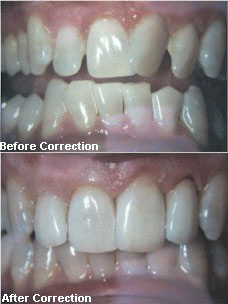also on this page (see below):
- Discolorization
- Crooks & Crowds
- Lost Teeth
What can you do?
 Several
treatment options are available for people who have chipped, cracked, or worn
teeth. The most commonly used correction methods include veneers and bonding.
These options present durable, cost effective alternatives to crowns and provide
healthier smiles. Both of these procedures involve bonding a porcelain or resin
material to a damaged tooth, then sculpting and polishing it to the desired
shape.
Several
treatment options are available for people who have chipped, cracked, or worn
teeth. The most commonly used correction methods include veneers and bonding.
These options present durable, cost effective alternatives to crowns and provide
healthier smiles. Both of these procedures involve bonding a porcelain or resin
material to a damaged tooth, then sculpting and polishing it to the desired
shape.
These procedures can be done to fill in cracks, even out chips, or build up
worn down teeth. They can also be used to close gaps or disguise discolored
teeth that do not respond well to whitening procedures.
Bonding is a relatively simple procedure that can usually be accomplished in
a single visit.
Veneers are custom made and thus stronger and longer lasting, but the process
requires more time and more than one appointment.
Caring for either bonded teeth or veneers will still require good oral
hygiene at home and regular check-ups.
Crooked or Crowded Teeth
People who want to straighten their crowded or crooked teeth have many
options available to them. (See: Before / After Photo)
Orthodontics can be used to reposition or straighten crowded or crooked
teeth, or to close gaps between them. This is usually done with braces, whether
they’re traditional “invisible” clear‚ acrylic‚ or “removable” ones used to
reposition only one or two teeth.
Dentists can often help relieve crowding or crookedness by pulling one or
more select teeth. Minor changes can also be accomplished through porcelain
veneers and bonding. With these two procedures, thin layers of
tooth-colored-porcelain or resin are bonded directly to the teeth for maximum
esthetic results and minimum tooth reduction.
This can then result in a straightened or aligned dental appearance without
the use of braces.
A dentist should review the whole range of treatment options available with
each patient. This review should include details of the scope and length of the
treatment, costs and insurance coverage, and answers to any questions.
“Before and after” photographs can provide an idea of the appearance
changes.
Discolored Teeth
Why do teeth become discolored? If a tooth is traumatized during some type of
accident, blood vessels in the tooth’s pulp will rupture and impart a dark
coloration to the natural appearance of the crown.
Also, discoloration can be caused if a silver amalgam restoration, or
filling, is placed in the tooth. Tobacco, certain foods, and drinks such as
coffee, tea, and red wine can also stain teeth. Cut down on the consumption of
these items and brush regularly to prevent most discoloration.
Severely stained teeth may need to be bleached in order to restore whiteness.
Bleaching is a procedure most effectively done by a dentist, in which a solution
is applied to the enamel of the teeth, whitening any surface discoloration.
Bleaching kits may be provided by your dentist to whiten your teeth at home.
Be sure to understand the complete instructions before use.
Internal discoloration caused by fillings or broken blood vessels may need to
be corrected with veneers. Veneers are coverings applied to tooth surfaces that
are specifically created to match the original color and shape of your existing
teeth.
Lost Teeth
A tooth can be lost for a number of reasons, including dental decay,
periodontal disease, injuries, and accidents. Though some my think that a
missing tooth is only a cosmetic problem, losing a tooth can be a psychological
and physical difficulty.
When a permanent tooth is lost, the neighboring teeth are also affected. The
support and chewing forces are altered when a tooth is missing and the remaining
teeth will begin to shift. The tooth above or below the one that was lost will
begin to move up and out of its socket.
This accelerates periodontal disease, often referred to as gum disease, and
causes further breakdown in the dental tooth arch. If the missing tooth is not
replaced, more teeth will eventually be lost, due to the improper forces exerted
during chewing.
Crowns and bridges are the most common methods for correcting major
functional or structural problems with individual teeth, missing teeth, or
general bite dysfunction.
High quality porcelain and ceramic materials are available to replace missing
or severely chipped teeth, making the replacement virtually undetectable.
Dental implants are also being used to successfully replace teeth for people
in all age groups.